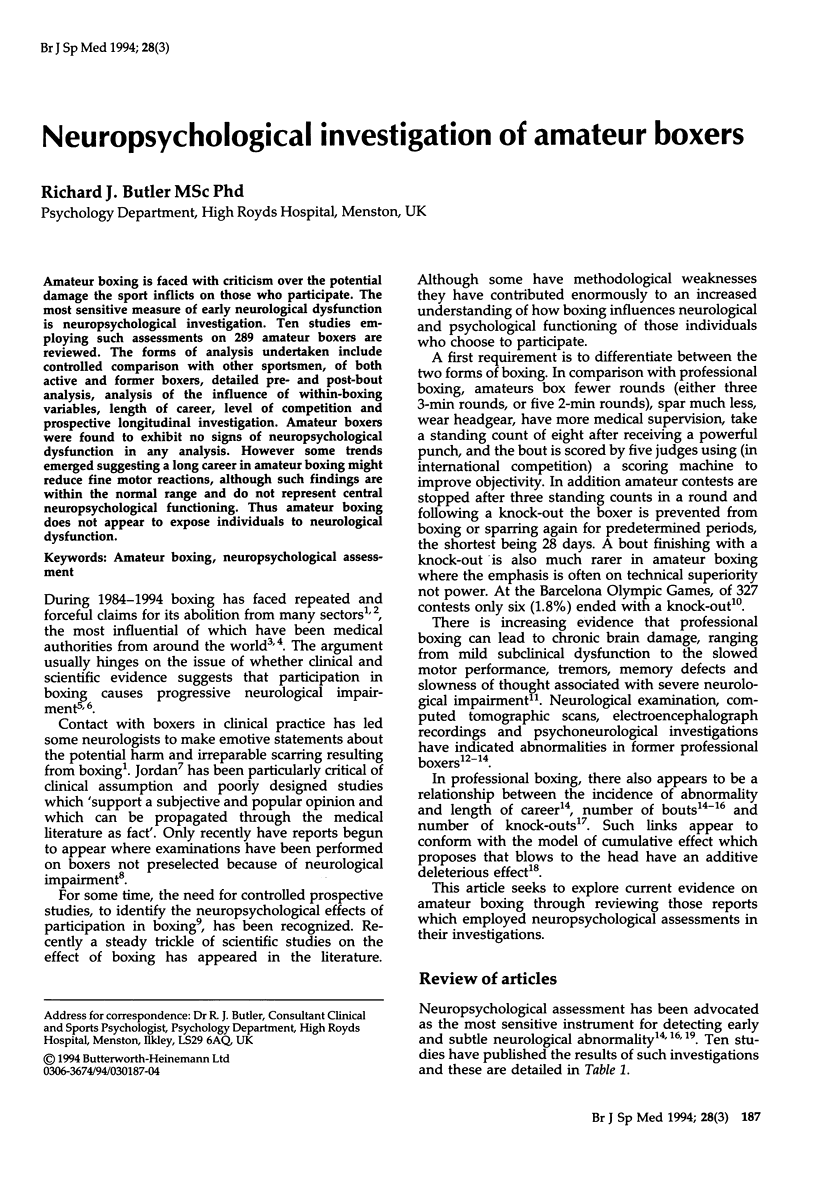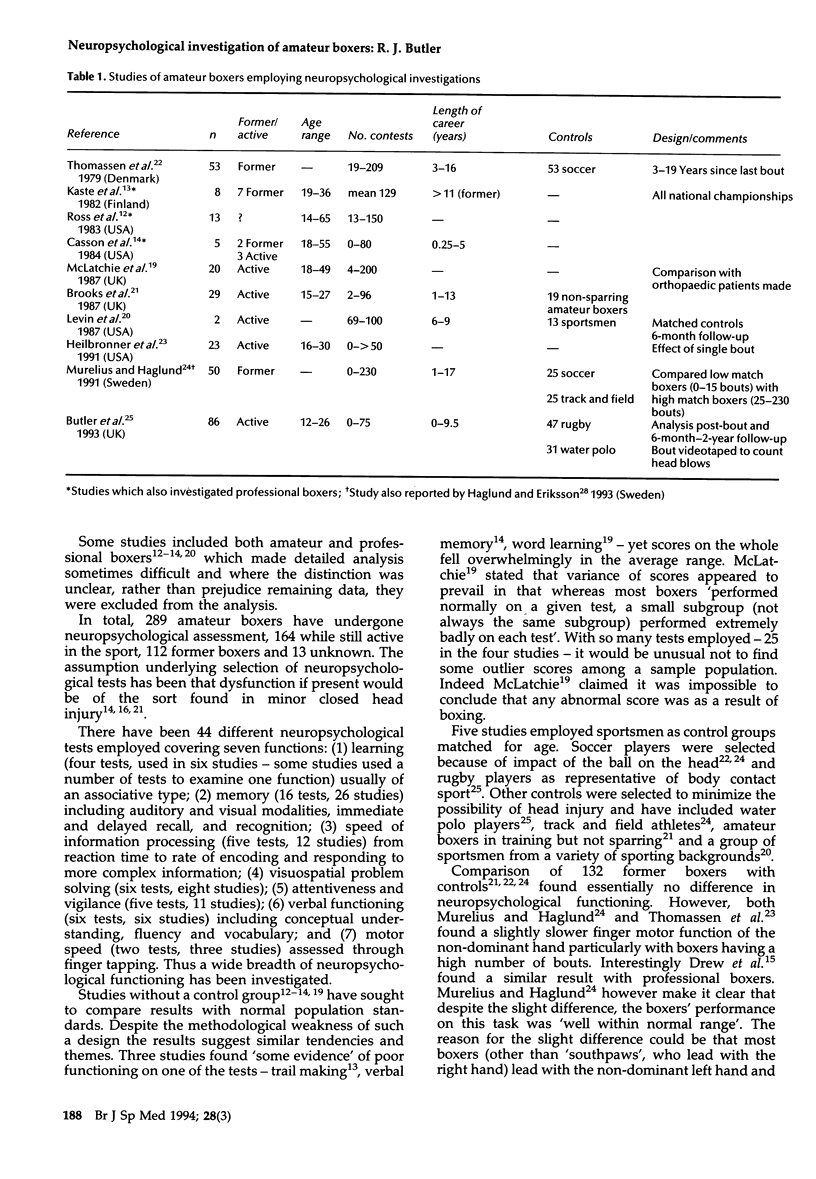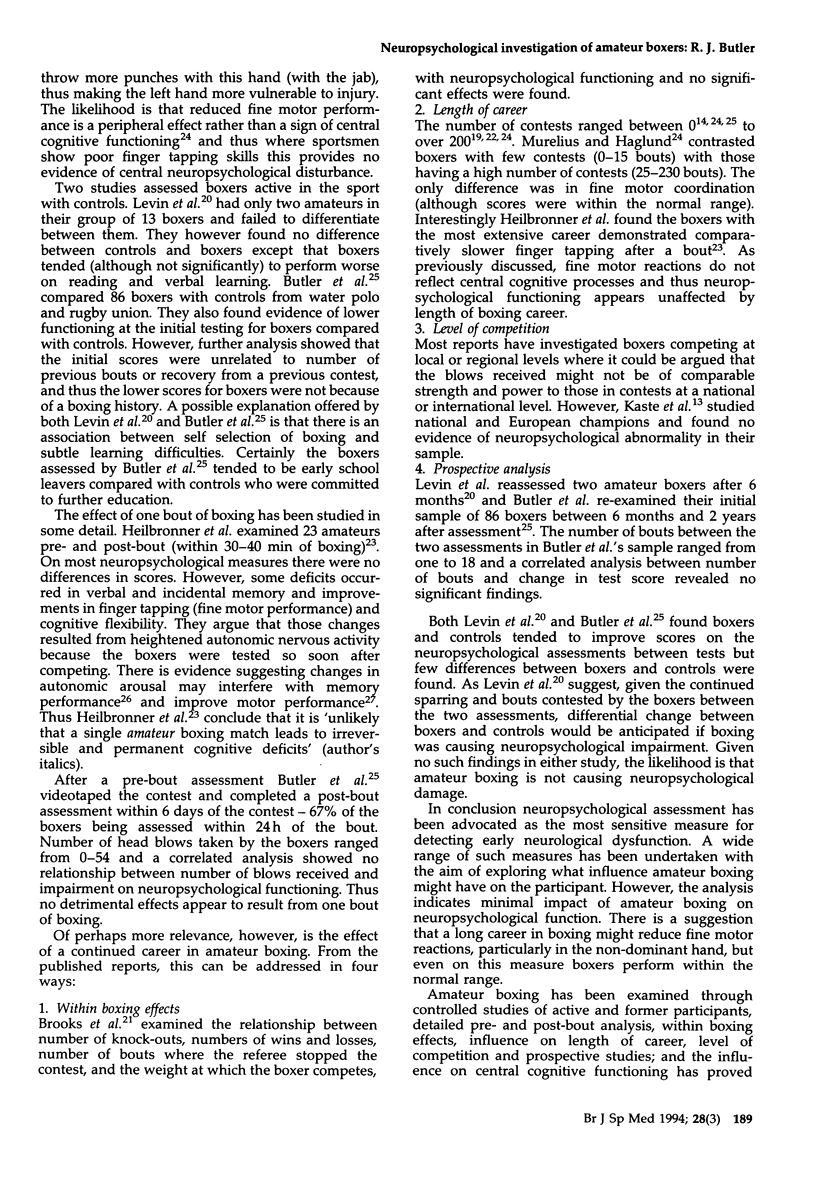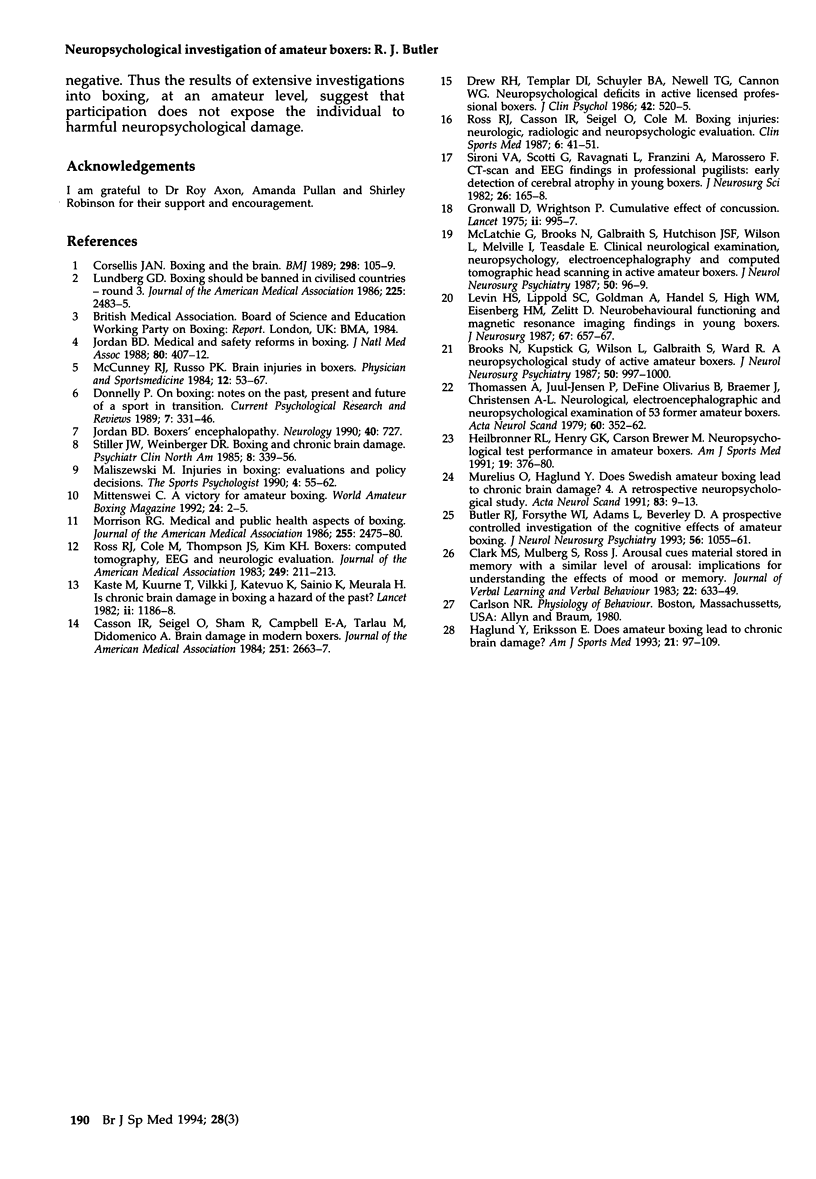Abstract
Amateur boxing is faced with criticism over the potential damage the sport inflicts on those who participate. The most sensitive measure of early neurological dysfunction is neuropsychological investigation. Ten studies employing such assessments on 289 amateur boxers are reviewed. The forms of analysis undertaken include controlled comparison with other sportsmen, of both active and former boxers, detailed pre- and post-bout analysis, analysis of the influence of within-boxing variables, length of career, level of competition and prospective longitudinal investigation. Amateur boxers were found to exhibit no signs of neuropsychological dysfunction in any analysis. However some trends emerged suggesting a long career in amateur boxing might reduce fine motor reactions, although such findings are within the normal range and do not represent central neuropsychological functioning. Thus amateur boxing does not appear to expose individuals to neurological dysfunction.
Full text
PDF



Selected References
These references are in PubMed. This may not be the complete list of references from this article.
- Brooks N., Kupshik G., Wilson L., Galbraith S., Ward R. A neuropsychological study of active amateur boxers. J Neurol Neurosurg Psychiatry. 1987 Aug;50(8):997–1000. doi: 10.1136/jnnp.50.8.997. [DOI] [PMC free article] [PubMed] [Google Scholar]
- Butler R. J., Forsythe W. I., Beverly D. W., Adams L. M. A prospective controlled investigation of the cognitive effects of amateur boxing. J Neurol Neurosurg Psychiatry. 1993 Oct;56(10):1055–1061. doi: 10.1136/jnnp.56.10.1055. [DOI] [PMC free article] [PubMed] [Google Scholar]
- Casson I. R., Siegel O., Sham R., Campbell E. A., Tarlau M., DiDomenico A. Brain damage in modern boxers. JAMA. 1984 May 25;251(20):2663–2667. [PubMed] [Google Scholar]
- Corsellis J. A. Boxing and the brain. BMJ. 1989 Jan 14;298(6666):105–109. doi: 10.1136/bmj.298.6666.105. [DOI] [PMC free article] [PubMed] [Google Scholar]
- Drew R. H., Templer D. I., Schuyler B. A., Newell T. G., Cannon W. G. Neuropsychological deficits in active licensed professional boxers. J Clin Psychol. 1986 May;42(3):520–525. doi: 10.1002/1097-4679(198605)42:3<520::aid-jclp2270420319>3.0.co;2-6. [DOI] [PubMed] [Google Scholar]
- Gronwall D., Wrightson P. Cumulative effect of concussion. Lancet. 1975 Nov 22;2(7943):995–997. doi: 10.1016/s0140-6736(75)90288-3. [DOI] [PubMed] [Google Scholar]
- Haglund Y., Eriksson E. Does amateur boxing lead to chronic brain damage? A review of some recent investigations. Am J Sports Med. 1993 Jan-Feb;21(1):97–109. doi: 10.1177/036354659302100117. [DOI] [PubMed] [Google Scholar]
- Heilbronner R. L., Henry G. K., Carson-Brewer M. Neuropsychologic test performance in amateur boxers. Am J Sports Med. 1991 Jul-Aug;19(4):376–380. doi: 10.1177/036354659101900409. [DOI] [PubMed] [Google Scholar]
- Jordan B. D. Boxer's encephalopathy. Neurology. 1990 Apr;40(4):727–727. doi: 10.1212/wnl.40.4.727. [DOI] [PubMed] [Google Scholar]
- Jordan B. D. Medical and safety reforms in boxing. J Natl Med Assoc. 1988 Apr;80(4):407–412. [PMC free article] [PubMed] [Google Scholar]
- Kaste M., Kuurne T., Vilkki J., Katevuo K., Sainio K., Meurala H. Is chronic brain damage in boxing a hazard of the past? Lancet. 1982 Nov 27;2(8309):1186–1188. doi: 10.1016/s0140-6736(82)91203-x. [DOI] [PubMed] [Google Scholar]
- Levin H. S., Lippold S. C., Goldman A., Handel S., High W. M., Jr, Eisenberg H. M., Zelitt D. Neurobehavioral functioning and magnetic resonance imaging findings in young boxers. J Neurosurg. 1987 Nov;67(5):657–667. doi: 10.3171/jns.1987.67.5.0657. [DOI] [PubMed] [Google Scholar]
- Lundberg G. D. Boxing should be banned in civilized countries--round 3. JAMA. 1986 May 9;255(18):2483–2485. doi: 10.1001/jama.255.18.2483. [DOI] [PubMed] [Google Scholar]
- McLatchie G., Brooks N., Galbraith S., Hutchison J. S., Wilson L., Melville I., Teasdale E. Clinical neurological examination, neuropsychology, electroencephalography and computed tomographic head scanning in active amateur boxers. J Neurol Neurosurg Psychiatry. 1987 Jan;50(1):96–99. doi: 10.1136/jnnp.50.1.96. [DOI] [PMC free article] [PubMed] [Google Scholar]
- Morrison R. G. Medical and public health aspects of boxing. JAMA. 1986 May 9;255(18):2475–2480. [PubMed] [Google Scholar]
- Murelius O., Haglund Y. Does Swedish amateur boxing lead to chronic brain damage? 4. A retrospective neuropsychological study. Acta Neurol Scand. 1991 Jan;83(1):9–13. doi: 10.1111/j.1600-0404.1991.tb03952.x. [DOI] [PubMed] [Google Scholar]
- Ross R. J., Casson I. R., Siegel O., Cole M. Boxing injuries: neurologic, radiologic, and neuropsychologic evaluation. Clin Sports Med. 1987 Jan;6(1):41–51. [PubMed] [Google Scholar]
- Ross R. J., Cole M., Thompson J. S., Kim K. H. Boxers--computed tomography, EEG, and neurological evaluation. JAMA. 1983 Jan 14;249(2):211–213. doi: 10.1001/jama.249.2.211. [DOI] [PubMed] [Google Scholar]
- Sironi V. A., Scotti G., Ravagnati L., Franzini A., Marossero F. CT-scan and EEG findings in professional pugilists: early detection of cerebral atrophy in young boxers. J Neurosurg Sci. 1982 Jul-Sep;26(3):165–168. [PubMed] [Google Scholar]
- Stiller J. W., Weinberger D. R. Boxing and chronic brain damage. Psychiatr Clin North Am. 1985 Jun;8(2):339–356. [PubMed] [Google Scholar]
- Thomassen A., Juul-Jensen P., de Fine Olivarius B., Braemer J., Christensen A. L. Neurological, electroencephalographic and neuropsychological examination of 53 former amateur boxers. Acta Neurol Scand. 1979 Dec;60(6):352–362. doi: 10.1111/j.1600-0404.1979.tb07661.x. [DOI] [PubMed] [Google Scholar]


